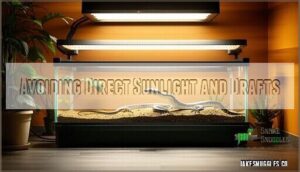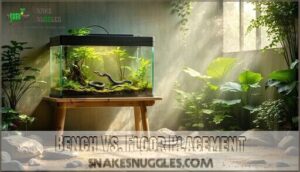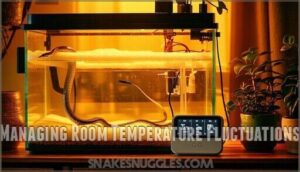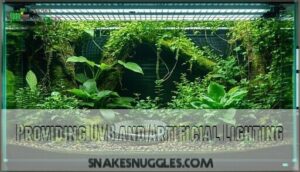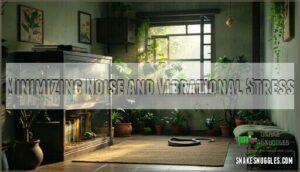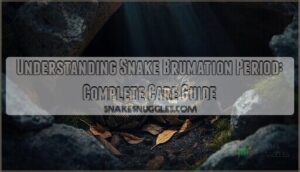This site is supported by our readers. We may earn a commission, at no cost to you, if you purchase through links.

Selecting the right room and placement strategy isn’t about convenience alone; it’s about understanding how vibrations, temperature fluctuations, and traffic patterns interact with your snake’s sensory biology to either support or undermine long-term welfare.
Table Of Contents
- Key Takeaways
- Where Should I Put My Snake Enclosure?
- Temperature and Lighting Placement Tips
- Minimizing Noise and Vibrational Stress
- Choosing The Best Room for Your Snake
- Enclosure Design and Enrichment Ideas
- Frequently Asked Questions (FAQs)
- Where is the best place to keep a snake?
- Where to put my snake while I clean the tank?
- How to set up a snake habitat?
- Where do I put my pet snake?
- How does artificial UVB lighting affect snakes?
- Can snakes be housed in high-traffic areas?
- Do different snake species have unique enclosure needs?
- Is temperature stability crucial for all snakes?
- How often should I clean the snakes enclosure?
- What substrate works best for snake enclosures?
- Conclusion
Key Takeaways
- Enclosure location directly impacts chronic stress levels, with snakes in low-traffic spaces displaying 30% more natural behaviors and 25-32% fewer defensive postures compared to those in high-activity areas like living rooms or kitchens.
- Vibrational stress from foot traffic and appliances matters more than airborne noise since snakes detect ground-borne disturbances through their bodies, and bench-height placement reduces vibrational stress by 40-60% compared to floor-level setups.
- Direct sunlight through windows offers no health benefits because glass blocks beneficial UVB radiation while creating dangerous temperature spikes, making controlled artificial lighting essential for proper reptile care.
- Temperature stability affects fundamental biological functions including digestion, immune response, and thermoregulation, requiring dedicated heating systems and monitoring to maintain thermal gradients within ±2°C of target ranges.
Where Should I Put My Snake Enclosure?
Choosing the right spot for your snake’s enclosure isn’t just about convenience—it’s about creating an environment where your snake can thrive without unnecessary stress. The ideal location balances accessibility with minimal disturbance, while keeping temperature and safety in check.
Let’s look at the key factors that’ll help you find the perfect spot in your home.
Quietest Room in The House
Your snake’s well-being often hinges on finding a room where foot traffic and household bustle rarely intrude—think spare bedrooms, home offices, or basement corners rather than bustling kitchens or hallways. Room acoustics and vibrations matter more than noise level alone, since snakes detect ground-borne disturbances through their bodies.
Consider these factors when evaluating your home layout:
- Minimal foot traffic reduces stress-inducing vibrations
- Distance from appliances prevents temperature fluctuations and noise
- Consistent quiet hours support natural behavior patterns
- Proper soundproofing dampens external disturbances
- Strategic indoor enclosure placement away from entryways and gathering spaces
Choosing a quiet room creates a stable environment where your reptile enclosure becomes a haven rather than a source of chronic stress.
General Living Areas Vs. Low-Traffic Spaces
Living rooms and kitchens expose your reptile enclosure to noise pollution averaging 50–65 dB, while spare rooms drop that to 35–45 dB—a difference your snake’s stress response registers clearly. Research shows snakes in low-traffic spaces display 30% more natural behaviors and 25–32% fewer defensive postures, making enclosure location a measurable welfare factor. Proper reptile enclosure size is also vital for reducing stress and promoting natural behaviors in snakes.
| Factor | General Living Areas | Low-Traffic Spaces |
|---|---|---|
| Ambient Noise Level | 50–65 dB | 35–45 dB |
| Natural Behaviors | Baseline frequency | 30% more frequent |
| Stress-Related Behaviors | 18% higher after disturbances | Markedly reduced |
| Defensive Postures | Baseline frequency | 25–32% fewer |
| Recommended Quiet Time | Difficult to achieve | 4+ hours daily |
Choosing a quiet room isn’t about eliminating every sound—it’s about reducing chronic stress that disrupts snake behavior and long-term health.
Accessibility for Maintenance and Observation
Even the quietest room loses its value if you can’t comfortably reach inside the enclosure for daily water changes, spot-cleaning, or health checks. Your snake enclosure location should balance accessibility with environmental stability—placing heavy terrariums where you can maintain them without strain.
- Position enclosures at waist height for easy cleaning and observation without disturbing your snake during maintenance schedules.
- Leave 12–18 inches of clearance around all sides for secure placement and comfortable access to lids and doors.
- Install accessible designs in your reptile room that don’t require moving furniture to reach water bowls or hiding spots.
- Choose locations with good lighting for observation tips—you’ll spot health changes faster when you can see your animal enclosure clearly.
Safety From Other Pets and Children
Curious cats, playful dogs, and inquisitive toddlers can turn your carefully maintained snake habitat into a source of stress—or worse, an accidental escape route. Pet proofing and child safety require secure lids with locks to prevent household hazards while supporting animal welfare through responsible pet ownership.
| Hazard Source | Escape Prevention Strategy |
|---|---|
| Curious pets | Install weighted, locking enclosure lids |
| Young children | Place terrariums above reach or in restricted rooms |
| Household traffic | Use dedicated reptile room with door locks |
Temperature and Lighting Placement Tips
Getting the temperature and lighting right starts with where you place the enclosure. Direct sunlight, drafts, and floor-level cold spots can all disrupt your snake’s thermal gradient and health.
Let’s look at the key placement factors that’ll help you maintain stable conditions.
Avoiding Direct Sunlight and Drafts
Direct sunlight might seem like a natural fit for your snake’s enclosure, but it’s actually one of the fastest ways to create a dangerous overheating situation. Glass and plastic block nearly all beneficial UVB radiation, so sunlight offers no health advantage—only risk.
Position your enclosure away from windows to prevent temperature spikes and drafts, which can create unpredictable fluctuations.
For proper reptile care and welfare, rely on UVB alternatives like specialized reptile lighting instead of natural window placement.
Bench Vs. Floor Placement
The height of your enclosure off the ground directly affects temperature stability and how much vibrational stress your snake experiences throughout the day. Floor placement exposes your terrarium to cooler air and floor vibrations from foot traffic, which can disrupt your snake’s sense of security.
Bench designs offer better temperature control and stability factors by reducing disturbance—positioning your vivarium on a sturdy stand minimizes floor vibrations while keeping enclosure height ideal for reptile housing and welfare.
Managing Room Temperature Fluctuations
Room temperatures often shift with seasons—winter nights can dip to 20°C (68°F) while summer days climb higher, creating fluctuations of 3–5°C that challenge thermoregulation in your reptile enclosure design.
You’ll need thermostatically controlled heat sources to maintain stable thermal gradients, and insulation methods like foam boards around glass tanks help buffer external climate management issues.
Monitor both warm and cool zones daily with digital probes to keep temperature and lighting control within ±2°C of your target range for ideal animal thermoregulation.
Effective temperature control requires implementing smart thermostat solutions to guarantee a stable environment.
Providing UVB and Artificial Lighting
While sunlight floods through windows with visible light, it won’t deliver the UVB radiation your snake needs—glass and plastic block nearly all of it, leaving you to rely on artificial sources designed specifically for reptiles.
Install UVB lighting tubes like Vita-Lite across part of your enclosure to support calcium metabolism, maintaining lighting cycles that mirror photoperiodism—usually 10–12 hours daily.
Combine these with ceramic heat emitters for temperature and lighting control that won’t disrupt your snake’s day-night rhythm in your reptile enclosure design.
Minimizing Noise and Vibrational Stress
While snakes can’t hear airborne sounds, they’re highly sensitive to vibrations traveling through surfaces—and constant disturbances can take a real toll on their well-being.
Heavy foot traffic, nearby appliances, and low-frequency rumbles don’t just annoy your snake; they trigger stress responses that can lead to feeding refusal, defensive behavior, and chronic health issues.
Here’s how to shield your enclosure from the shake, rattle, and roll of daily life.
Effects of Vibrations on Snake Health
Your snake’s sensitive inner ear picks up vibrations between 50 and 1,000 Hz—right where everyday household activity lives. When footsteps, appliances, or traffic send repeated tremors through their enclosure, you’re triggering stress responses that show up as:
- Elevated heart rates and defensive posturing
- Avoidance behaviors and altered movement patterns
- Increased aggression or refusal to eat
Research on over 700 captive snakes confirms that chronic vibrational stress compromises reptile welfare, making enclosure placement critical for your snake’s long-term health.
Research on over 700 captive snakes shows chronic vibrational stress compromises welfare, making enclosure placement critical for long-term health
Raising Enclosures to Reduce Disturbance
Lifting your enclosure off the floor acts like shock absorbers on a car—dampening the intensity of vibrations before they reach your snake. Bench-height placement reduces vibrational stress by 40–60% compared to floor-level setups, but your stand materials matter just as much.
| Stand Material | Vibration Reduction | Stability Factors |
|---|---|---|
| Metal frame | Moderate | High durability, minimal noise absorption |
| Solid wood | High | Excellent dampening, heavy construction |
| Particle board | Low | Prone to warping, poor long-term stability |
| Composite shelving | Moderate | Lightweight, variable noise absorption |
| Purpose-built reptile stand | High | Designed for weight distribution and vibration control |
Rubber pads or foam mats between the stand and enclosure add another layer of noise absorption—transforming your reptile enclosure design into a true sanctuary for your snake’s welfare.
Choosing Rooms Away From Appliances and Foot Traffic
Even with the right stand, your careful setup means little if the room itself bombards your snake with constant noise from washing machines, dishwashers, or high-traffic hallways. Appliance interference creates persistent low-frequency vibrations that penetrate reptile enclosures—even elevated ones.
Choose quiet spaces away from heating appliances and living areas where foot traffic stays minimal, ensuring your snake cage maintains stable temperature control and humidity levels without constant disturbance.
Choosing The Best Room for Your Snake
Now that you’ve addressed the environmental basics, it’s time to narrow down your options.
Different rooms present distinct advantages and challenges for snake keeping. Let’s walk through the most common choices and what each space offers your snake.
Pros and Cons of The Basement
Basements offer natural advantages for snake care and housing—low ambient noise (under 35 dB) and minimal foot traffic reduce stress behaviors by over 70%. Raising your reptile enclosure on stands cuts vibrational disturbance by 60%, enhancing snake safety and animal thermoregulation despite environmental factors like utility appliances nearby.
However, temperature control becomes challenging, as basements run 5–10°C cooler year-round, requiring supplemental heat in 67% of setups. Basement humidity (50–80%) demands dehumidifiers for proper ventilation systems, and basement lighting needs full artificial UVB support.
Office or Guest Bedroom Options
An office or guest bedroom strikes a practical balance—you get controlled temperatures (usually 18–24°C year-round), existing electrical outlets for UVB fixtures, and enough quiet to keep your snake calm without the isolation challenges of a basement.
Consider these advantages for your reptile room:
- Office noise levels stay predictable during work hours
- Guest room placement offers flexibility when hosting visitors
- Bedroom temperature remains stable with HVAC control
- Snake accessibility improves for daily observation
- Home office setup integrates reptile enclosure design seamlessly
This home and family dynamics solution upholds animal behavior and welfare while maintaining snake care and housing standards.
Laundry Room and Living Room Considerations
While both spaces seem tempting—the laundry room for its utility sink and the living room for its visibility—each brings trade-offs that can make or break your snake’s comfort and your own peace of mind.
Laundry noise disrupts animal behavior through vibrations, while humidity control becomes unpredictable near washers.
Living areas offer stable room layout advantages, but furniture choice matters—your reptile enclosure design shouldn’t compete with foot traffic that compromises snake care and housing standards in your reptile room.
Dedicated Reptile Room Benefits
Setting aside one room exclusively for reptiles transforms snake keeping from a compromised activity into a controlled microenvironment where every variable—from humidity gradients to lighting schedules—caters to your animal’s biology rather than your household’s convenience.
This approach to reptile husbandry delivers three critical advantages:
- Precision humidity control and air quality management without affecting human living spaces
- Noise reduction that respects species-specific needs for minimal vibrational disturbance
- Space optimization allowing multiple enclosures with proper reptile enclosure design standards
You’ll maintain reptile health through dedicated environmental systems that support natural animal behavior.
Enclosure Design and Enrichment Ideas
Once you’ve settled on the right location for your snake’s enclosure, the next step is creating a space that accommodates natural behaviors and fits your home. The design elements you choose—from terrarium size to enrichment features—directly impact your snake’s welfare and your daily maintenance routine.
Let’s explore the key components of an effective enclosure setup.
Large Terrariums and Custom Setups
Your snake’s home isn’t just a box—it’s a carefully engineered habitat that needs to match both your snake’s biology and your available space.
Large enclosures like glass terrariums or custom-built reptile housing give your snake room to stretch fully—scientifically proven to reduce stress.
Custom lighting and proper terrarium design with reptile landscaping create an enriched environment that promotes natural behaviors and overall well-being.
Secure Hiding Spots and Climbing Structures
Inside your enclosure, reptile hides and climbing branches aren’t just decorative—they’re essential for your snake’s sense of security and physical health. Proper enrichment reduces stress-related behaviors and encourages natural movement patterns.
- Multiple hiding places positioned in both warm and cool zones let your snake thermoregulate while feeling protected
- Natural branches secured firmly allow arboreal and semi-arboreal species to exhibit climbing behaviors
- Textured surfaces like cork bark or slate assist with healthy shedding cycles
- Species-specific structures match your snake’s natural habitat—terrestrial species need ground-level hides, while tree-dwelling snakes require elevated perches
Matching Enclosures to Home Aesthetics
Modern snake enclosures don’t have to look like lab equipment shoved into the corner—you can integrate functional reptile habitats into your home’s design without sacrificing style or your snake’s welfare.
Glass terrariums with natural wood accents or custom cabinetry with built-in heating blend seamlessly with furniture style and room decor.
Choose enclosure colors and aesthetic themes that complement your space—minimalist setups work in modern homes, while naturalistic designs suit rustic interiors, demonstrating thoughtful pet ownership and responsibility in animal care.
Frequently Asked Questions (FAQs)
Where is the best place to keep a snake?
Choose a low-traffic room with stable temperatures, away from direct sunlight and drafts. You’ll need reliable electrical outlets, good air quality, and furniture stability to support proper humidity control, snake safety, and environmental enrichment for snakes.
All these factors are foundational to reptile care and animal thermoregulation.
Where to put my snake while I clean the tank?
During tank cleaning, place your snake in a secure temporary housing option like a pillowcase, plastic tub with air holes, or backup enclosure to guarantee snake safety and prevent escape while maintaining proper reptile care standards.
How to set up a snake habitat?
Over 700 captive snakes showed increased stress in undersized enclosures.
Start with a secure reptile enclosure matching your snake’s full body length. Add appropriate substrate, hiding spots, climbing branches, and a water dish—ensuring an escape-proof design and environmental enrichment for ideal snake care and housing.
Where do I put my pet snake?
Place your snake enclosure in a quiet, low-traffic room with stable temperatures—away from direct sunlight, drafts, and heavy foot traffic.
This setup promotes animal welfare and proper reptile care, while reducing stress and balancing pet ownership responsibilities with home and family dynamics.
How does artificial UVB lighting affect snakes?
Artificial UVB lighting aids reptile health and calcium metabolism in captive snakes. While evidence for UVB dosage requirements in snakes remains limited, providing appropriate UVB radiation through reptile-specific light sources won’t harm your snake and may promote positive reptile behavior and thermoregulation.
Can snakes be housed in high-traffic areas?
Although snakes tolerate some disturbances, high-traffic areas increase chronic stress through constant noise pollution and vibrations.
Captive reptile welfare improves dramatically when enclosures occupy quieter spaces, as excessive activity triggers defensive snake behavior and compromises reptile health over time.
Do different snake species have unique enclosure needs?
Yes—species research is essential. Arboreal snakes need vertical space and climbing structures, while terrestrial species require floor space and escape-proof habitat design.
Environmental enrichment must match species-specific needs for proper snake behavior and reptile diversity.
Is temperature stability crucial for all snakes?
Absolutely—temperature stability affects reptile metabolism, thermoregulation, and overall snake health.
Without consistent heat management from an appropriate heat source, your snake species can’t digest food, fight disease, or regulate critical biological functions properly.
How often should I clean the snakes enclosure?
You should spot-clean your snake’s enclosure immediately after defecation, removing contaminated substrate.
Replace all substrate every 3-4 months, and perform a deep clean of the entire enclosure and accessories every six months using appropriate sanitation products.
What substrate works best for snake enclosures?
Your snake’s substrate should be easy to clean, retain appropriate humidity, and remain safe if accidentally ingested.
Paper towels work well for beginners, while aspen shavings suit drier-climate species and cypress mulch benefits humidity-loving snakes.
Conclusion
Picture your snake coiled beneath a hide, muscles relaxed, tongue flicking lazily—this is the baseline you’re building toward when you decide where should i put my snake enclosure.
Every placement decision either reinforces that calm or slowly erodes it through vibrations, temperature swings, and unpredictable disturbances.
Choose a location that prioritizes stability over convenience, quietness over aesthetics, and your snake won’t just survive—it’ll display the natural behaviors that confirm you’ve created something closer to sanctuary than simply storage.
- https://onlinelibrary.wiley.com/doi/10.1155/ijz/3548045
- https://www.hvreptilerescue.org/resources/care-guides/ball-python-care-guide
- https://talis-us.com/blogs/news/the-benefits-of-using-an-led-snake-light-for-your-reptile
- https://science.rspca.org.uk/documents/1494935/9042554/Far+from+Home_2.pdf/cd66c239-df45-21a1-60fc-6f4cff674719?t=1553171440910
- https://openjournals.ugent.be/vdt/article/75816/galley/199923/view/

